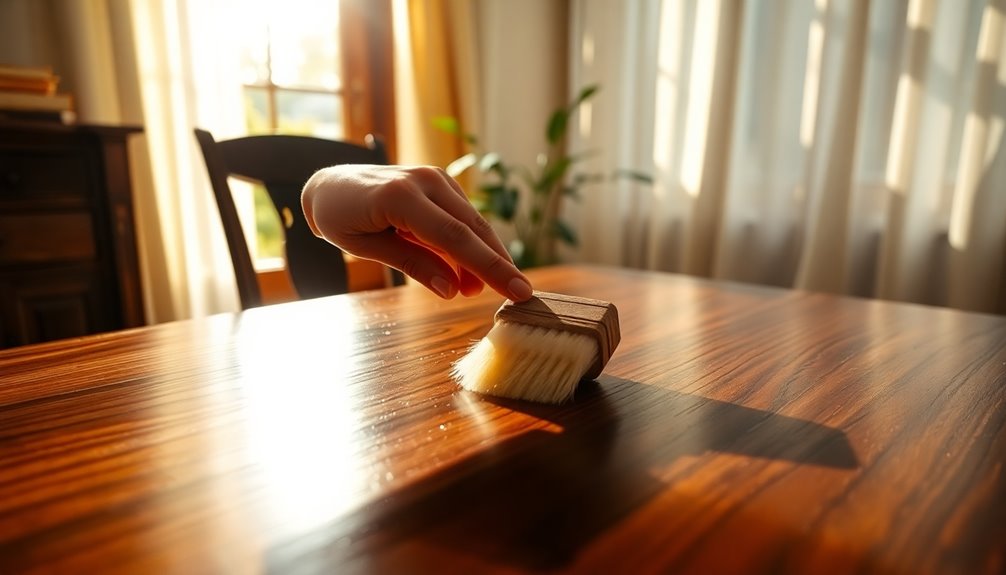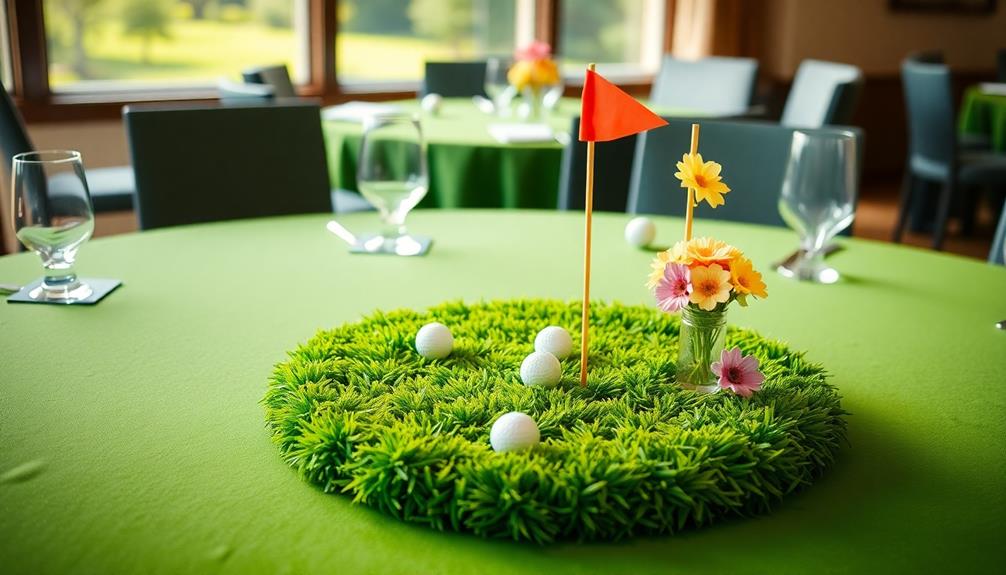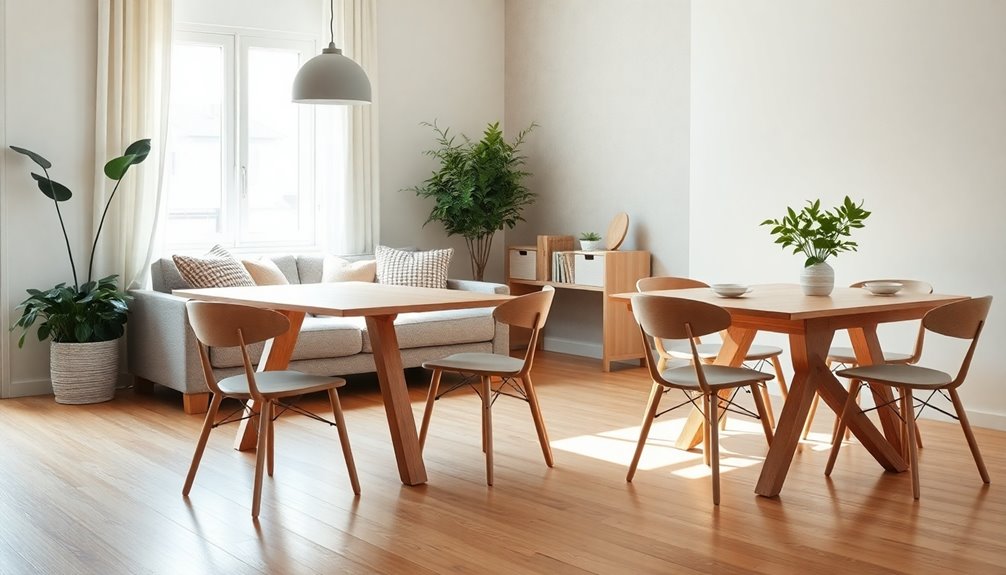To lighten dark wood furniture, start by stripping the existing finish using a chemical stripper. Once stripped, sand the surface with coarse to fine-grit sandpaper to prepare it for staining. You can use wood bleach for significant lightening or try whitewashing for a more subtle effect. After achieving the desired shade, apply a light-colored top coat for protection. Be sure to work in a well-ventilated area and follow safety precautions. Regular maintenance will help keep your furniture looking fresh. There's much more to explore to enhance your furniture transformation effectively.
Key Takeaways
- Strip the existing finish using a chemical stripper or Citristrip, then clean the residue thoroughly before proceeding.
- Sand the wood starting with coarse-grit sandpaper, then gradually move to finer grits for a smooth surface.
- Apply wood bleach or a lightening chemical to achieve uniform color lightening; test on scrap wood first.
- Use whitewashing or pickling techniques to lighten the wood while enhancing its grain for a vintage look.
- Finish with a light-colored top coat, sanding between applications for a more pronounced lightening effect.
Stripping the Existing Finish
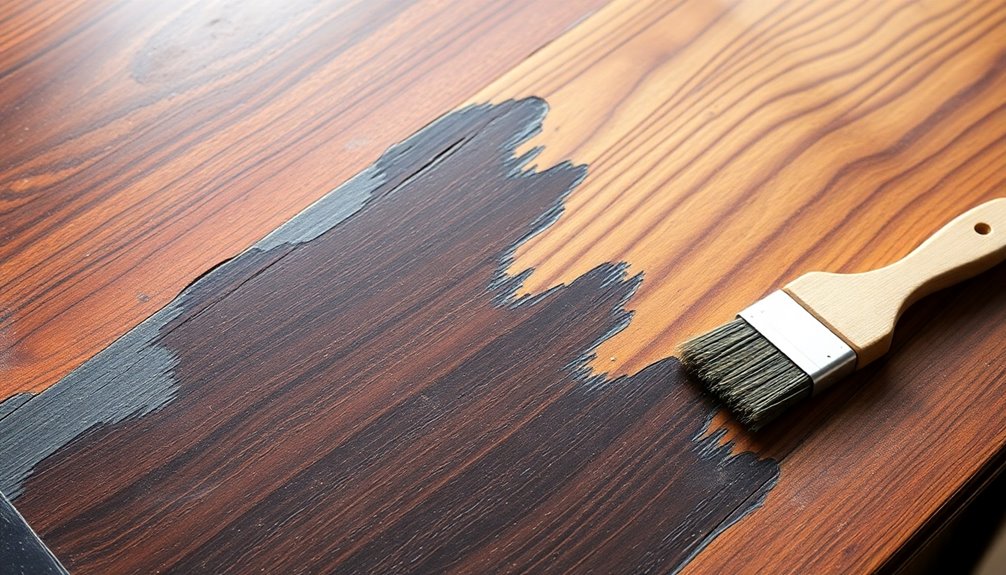
Stripping the existing finish from dark wood furniture can feel daunting, but it's a crucial step in achieving a lighter look. Start by choosing a chemical stripper or a method like Citristrip. If you opt for a chemical stripper, apply it evenly over the surface with a medium-sized paintbrush. Let it soak for 20 to 30 minutes to loosen the old finish. Then, carefully use a plastic scraper or a smooth putty knife to remove the old finish, being cautious not to damage the soft wood underneath. Clean up the residue with mineral spirits or the recommended solvent.
If you prefer the Citristrip method, apply a generous coat with a rag and let it sit for about an hour. After that, scrape off the loosened finish with a metal or plastic scraper, ensuring you scrape with the wood grain. For stubborn spots, you can use steel wool dipped in a thinner or apply alternative solvents like alcohol, working in small sections. Remember to always keep your workspace well-ventilated when using any chemicals. This prep work is essential for achieving that fresh, lighter look you desire, especially since Citristrip is recommended for its low fumes and effective results.
Sanding the Wood
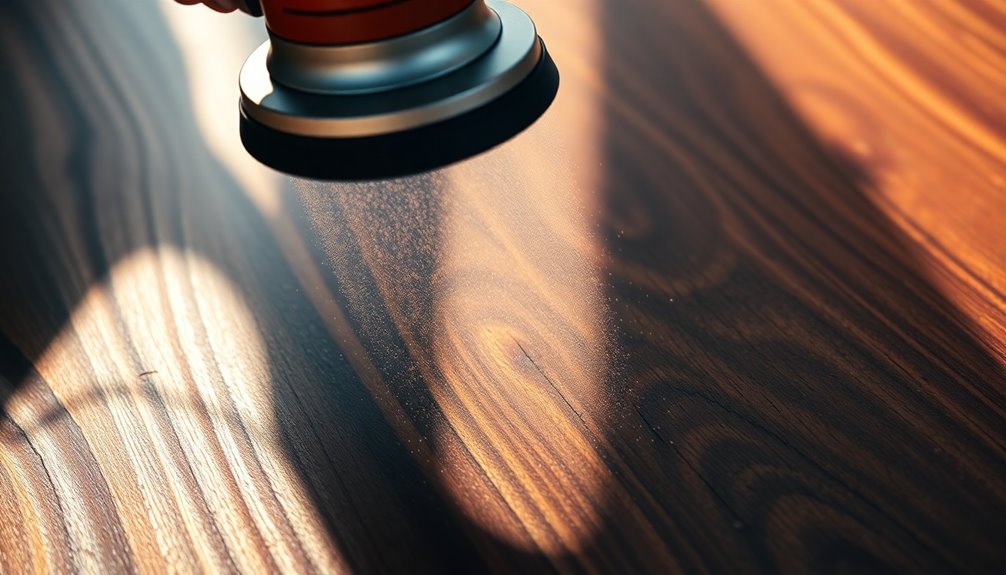
When it comes to lightening dark wood furniture, sanding the wood is a vital step that can significantly enhance the final result. Start with coarse-grit sandpaper (60-80 grit) to remove the existing stain and finish. Use long, even strokes along the grain to prevent scratches. For flat surfaces, employ a sanding block to maintain even pressure. When tackling curved areas, a thick piece of foam padding or a sponge covered with sandpaper works best.
As you progress, switch to medium-grit sandpaper (120-150 grit) for smoothing and finish with fine-grit sandpaper (220 grit) for a polished look. Make sure to use each grade of sandpaper on the entire piece before moving on, and be careful not to press too hard to avoid gouging. Solid wood tables can be refinished with basic tools, making this process accessible for most DIY enthusiasts.
Safety is crucial; use a proper respirator and safety glasses, and ensure your workspace is well-ventilated. After each sanding pass, clean the surface with a tack cloth to remove dust. Inspect the wood for defects, using a lightly dampened towel to highlight areas needing more attention. Work in small sections to achieve even results and avoid missing spots.
Using Wood Bleach
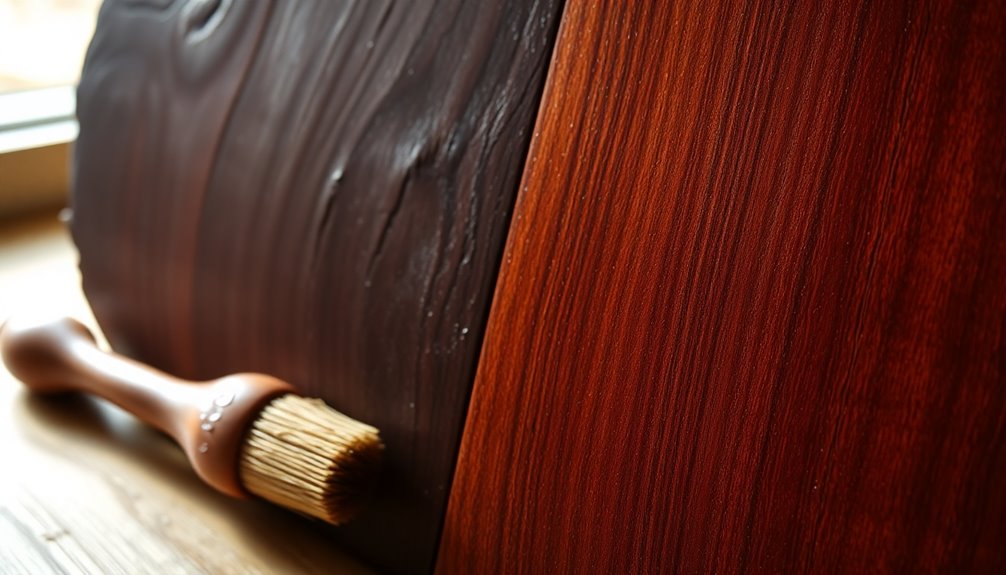
After sanding your wood furniture, using wood bleach can further lighten the piece and enhance its appearance. There are several types of wood bleach to consider. Laundry bleach is a mild option, effective for addressing color problems and removing stains, though it won't change the wood's natural color much. It's a good first step before trying stronger bleaches.
For more significant lightening, you might opt for a two-part commercial bleach. This powerful option can drastically alter the wood's color, making it suitable for darker pieces. However, be cautious, as it can cause violent reactions, so wear protective gear like rubber gloves and safety goggles.
Oxalic acid is another alternative, particularly useful for removing black water marks and restoring the wood's natural tone. Testing the bleach on scrap wood before applying it to your furniture is crucial for ensuring desired results. Apply it evenly across the surface for consistent results.
Regardless of the type you choose, always work in a well-ventilated area and keep safety precautions in mind. Store your bleach properly and dispose of any waste according to regulations. By following these steps, you can effectively lighten your dark wood furniture while ensuring safety throughout the process.
Utilizing Sunlight
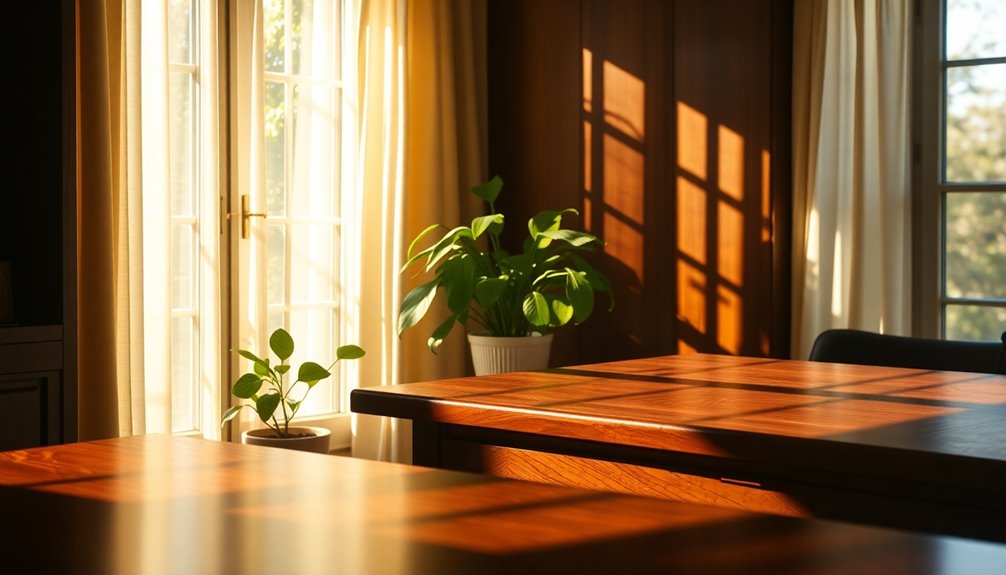
Utilizing sunlight can be a natural and effective way to lighten dark wood furniture over time. When exposed to UV rays, certain wood species, like cherry, undergo significant color changes, transforming from light brown to a rich medium brown. However, keep in mind that prolonged exposure can also lead to photodegradation, which affects the appearance of the wood surface. To counteract any potential damage from UV exposure, it’s essential to rotate the furniture periodically or use protective coverings when not in use. Additionally, incorporating a few light-colored decorative elements can create a balanced aesthetic, further enhancing the process of modernizing cherry wood furniture. By carefully managing sunlight exposure and combining it with thoughtful design choices, you can achieve a beautifully refreshed look for your space.
To achieve even color changes, consider architectural planning to distribute sunlight evenly across your furniture. Uneven exposure can create shadow lines and inconsistent color variations, so you might want to rotate your furniture periodically. Limiting direct sunlight can also help prevent excessive darkening, while using window treatments can manage UV exposure effectively. Additionally, lighter wood complements various interior design styles, making it a versatile choice for your decor.
If you notice uneven color changes, lightly sanding the surface can help blend the tones. You could also expose the lighter side to sunlight to help it catch up with the darker side. Just remember to ensure the wood is completely dry before attempting any corrective measures. Testing a small, inconspicuous area is always a smart move before applying any method, ensuring you maintain the wood's natural beauty.
Applying a Light-Colored Top Coat
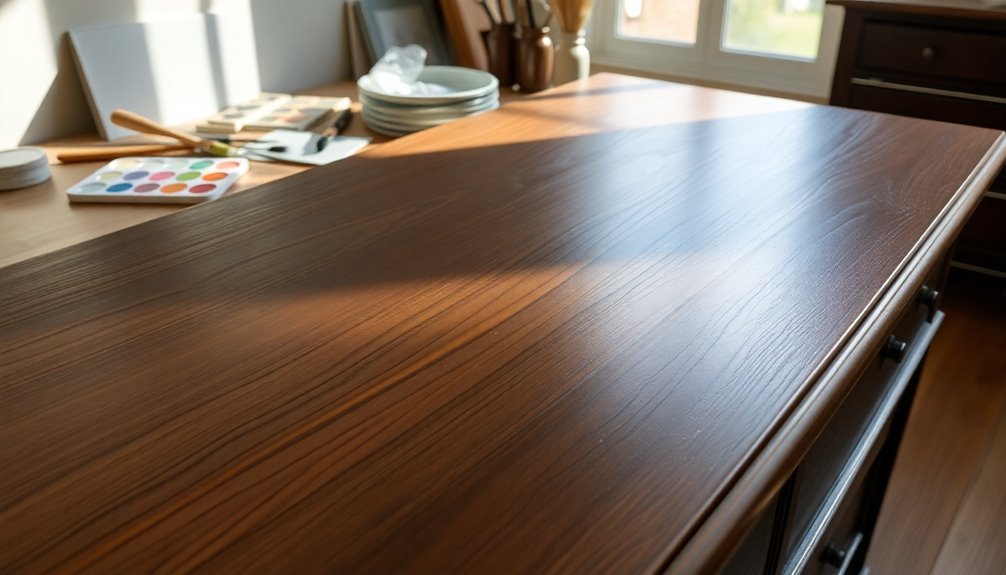
To effectively lighten dark wood furniture, applying a light-colored top coat is a straightforward and impactful method. Start by selecting a top coat that suits your needs, such as a whitewash, light stain, or light-toned polyurethane. Make sure the product you choose has a lightening effect while also protecting the wood. A water-based top coat can provide a lighter finish and is often easier to work with.
Before applying the top coat, prepare the wood surface by ensuring it's clean and completely dry. Lightly sand the surface with fine-grit sandpaper (220 grit) to achieve a smooth finish, and remove any dust or debris to promote good adhesion. Once that's done, use a clean brush or lint-free cloth to apply the top coat evenly, always working in the direction of the grain. Apply a thin layer to avoid over-saturation, and allow it to dry as per the manufacturer's instructions, usually a few hours. Multiple applications may be necessary for a more pronounced lightening effect.
If you desire a lighter appearance, feel free to apply additional coats. Lightly sand between coats for an even smoother finish, and once you achieve the desired lightness, consider sealing the surface for added protection.
Alternative Methods
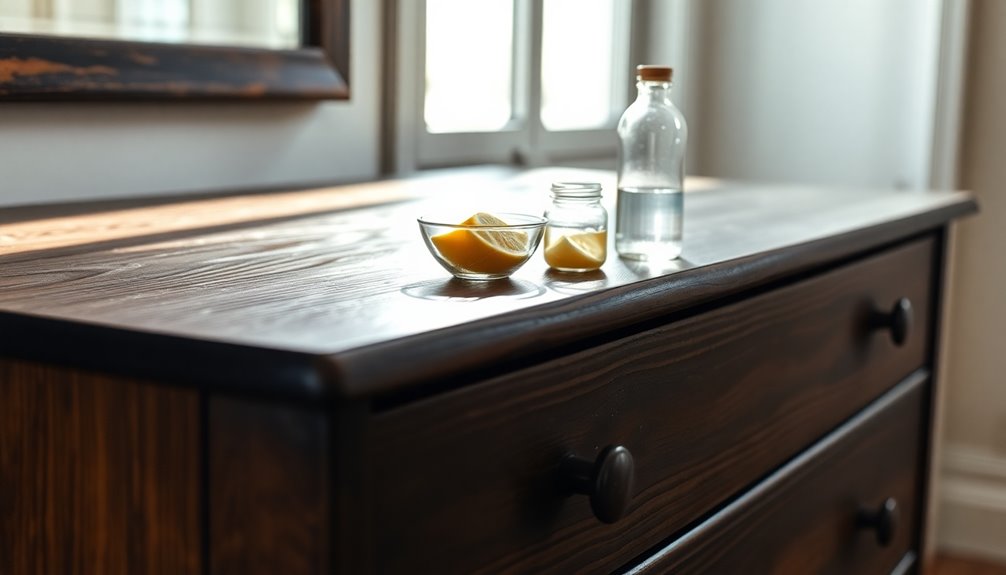
When you want to lighten dark wood furniture, there are several alternative methods that can achieve great results. One effective approach is using 0000-grade steel wool. Dampen it in warm water and gently run it along the wood grain to avoid scratching. If needed, you can add mineral spirits or turpentine, but be sure to apply light pressure and make multiple passes for the best outcome.
Another option is to use a paint and varnish stripper. This method removes the existing stain, allowing you to start fresh and apply a new finish. Combining this with other techniques can enhance your results, ensuring a clean surface for the new application.
Wood bleach is also a viable choice. You can use household bleach or specific wood bleach, following the manufacturer's instructions. Let it penetrate the wood for the recommended time, then neutralize it with a mixture of water and vinegar. You might need to sand the surface afterward for a smooth finish. Chemical options for uniform lightening can provide an effective solution without the need for sanding.
Lastly, consider whitewashing, pickling, or applying white wax. These methods lighten the wood while showcasing its grain, giving it a fresh and vintage appearance. Just remember to apply evenly and wipe off any excess.
Safety Precautions
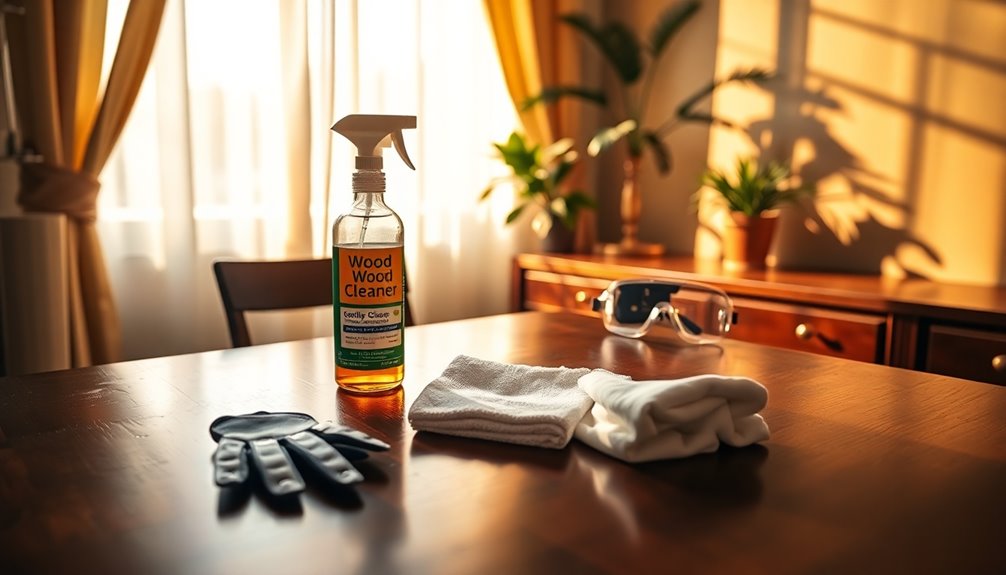
Lightening dark wood furniture can be rewarding, but it's important to prioritize safety throughout the process. Start by preparing your workspace. Make sure it's well-ventilated—open windows and use fans to keep air circulating. Choose a concrete surface to avoid damage from any chemicals and protect surrounding areas from spills. Remove any flammable materials and keep the space clean and clutter-free.
Next, gear up with personal protective equipment. Wear rubber gloves to shield your hands from caustic substances, and use eye goggles to protect your eyes from splashes. Don a dust mask when working with strong bleaches, and cover your skin with long sleeves and full-length pants. It's also essential to use appropriate bleach types that are safe and effective for your specific wood type.
When applying bleach or other chemicals, do so with care. Use a clean, soft rag or paintbrush and follow the manufacturer's instructions closely. Never mix bleach with other chemicals—this can lead to dangerous reactions. After applying, neutralize the wood using a mixture of water and vinegar, and rinse thoroughly. Ensure the wood is completely dry before proceeding, and clean the surface with a tack cloth to eliminate any residue. Prioritize these precautions for a safe and successful project.
Maintenance Tips
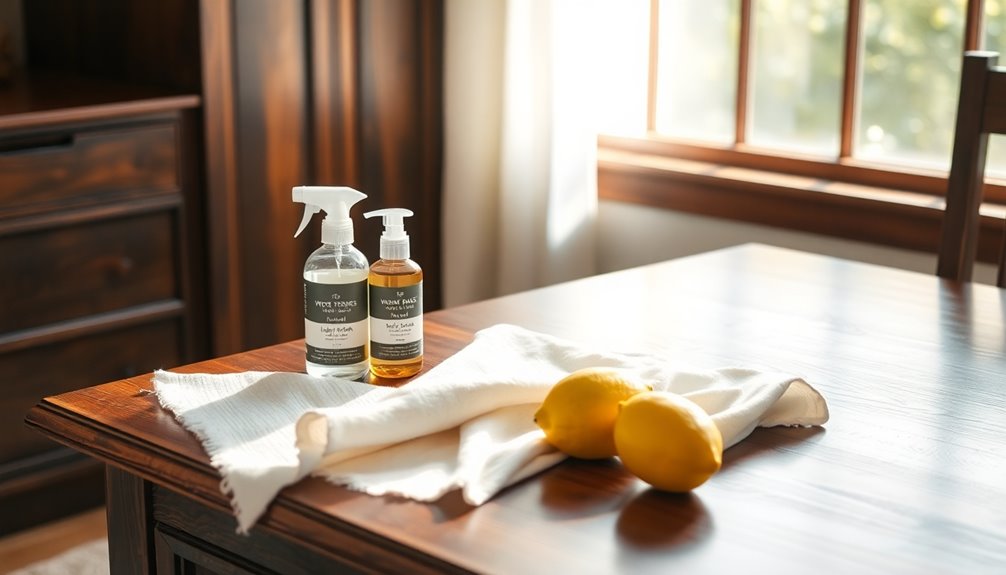
How can you keep your lightened wood furniture looking its best? Start by regularly dusting the surfaces to prevent dirt and grime from dulling the finish. Position your furniture away from direct sunlight to avoid fading or darkening over time. If spills occur, clean them immediately to protect the wood and its finish. Use gentle cleaners like mild soap and water, steering clear of harsh chemicals that could cause damage.
To protect the finish, apply a clear sealant, such as polyurethane or lacquer. Make sure to use thin coats, allowing each layer to dry fully, and lightly sand between coats for a smooth finish. Buffing with a soft cloth can enhance the wood's natural sheen. Additionally, ensure that the wood is properly prepared by stripping the finish, as this step is essential for achieving the best results in maintaining the appearance of your lightened furniture.
Prevent future darkening by using UV-resistant finishes and maintaining consistent humidity levels in your home. Keep the furniture away from extreme temperatures and chemicals that might harm the finish. Regularly inspect the furniture for signs of wear, and don't hesitate to apply touch-ups as needed. For long-term care, polish occasionally and monitor for moisture to ensure your furniture stays in great shape.
Frequently Asked Questions
Can I Lighten Wood Furniture Without Stripping the Finish?
Yes, you can lighten wood furniture without stripping the finish. Consider using wood bleach or a whitewash technique to achieve a lighter appearance while preserving the existing surface. You can also apply a light stain or liming wax to enhance the wood's brightness. If you want a more natural approach, using sunlight can gradually lighten the wood, though it takes time. Just ensure to clean the surface thoroughly before applying any treatment.
How Long Does It Take to Lighten Dark Wood Furniture?
It generally takes several hours to weeks to lighten dark wood furniture, depending on the method you choose and the intricacy of the piece. If you're sanding, you might spend 18-20 hours on detailed items, while applying wood bleach can be quicker, taking just a few hours plus drying time. Always factor in the time for neutralizing and additional drying after treatments to ensure the best results.
Will Lightening My Furniture Affect Its Durability?
Yes, lightening your furniture can affect its durability. If you don't seal the wood properly after lightening, it may become more vulnerable to damage. Techniques like sanding or bleaching can weaken the wood fibers if done excessively. Always apply a protective finish afterward to enhance durability and resist wear. Regular maintenance is essential to keep your furniture looking good, so be sure to check for scratches and address them promptly.
What Types of Wood Are Easiest to Lighten?
When you're looking to lighten wood, certain types make the process easier. Maple and pine respond well to bleaching, maintaining a bright appearance. Oak, particularly white and red oak, can also lighten significantly. Beech and ash are great choices, as they bleach easily, too. However, you might find that darker woods like walnut and cherry are more challenging. Always consider the wood's natural color and current finish before starting your project.
Can I Use Household Items to Lighten Wood?
Yes, you can use household items to lighten wood. Mixing household bleach with water can help, though it's not as effective as specialized wood bleach. Apply the mixture with a brush, let it sit, and rinse thoroughly. Alternatively, sanding with fine-grit sandpaper removes the top layer, revealing lighter wood underneath. You can also dilute regular wood stains to achieve a lighter color. Always remember to follow the wood grain and clean the surface before applying any treatments.
Conclusion
Lightening dark wood furniture can breathe new life into your space and enhance its beauty. By stripping the finish, sanding, and using bleach or sunlight, you can achieve the desired look. Don't forget to apply a light-colored top coat for a polished finish. Always prioritize safety and follow maintenance tips to keep your furniture looking great. With these simple steps, you'll transform your dark wood pieces into bright, inviting accents in your home. Happy DIYing!
